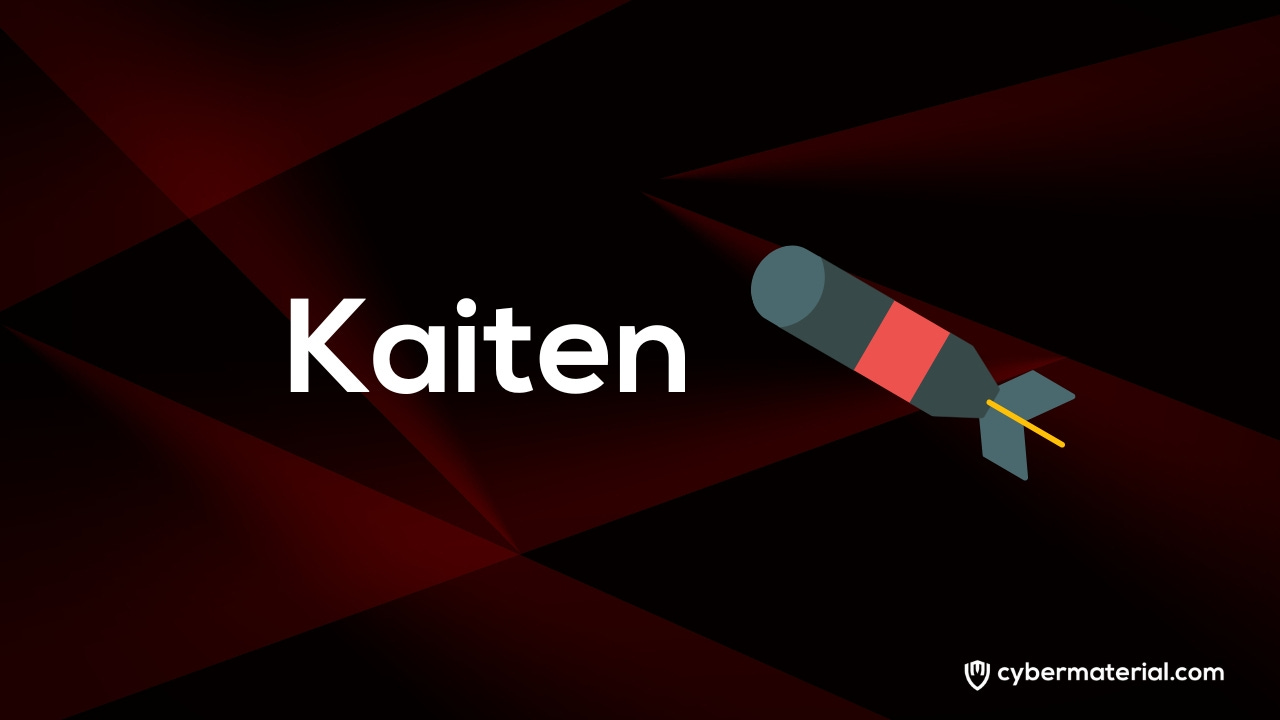
Kaiten
Type of Malware
Trojan
Country of Origin
Unknown
Date of initial activity
2014
Targeted Countries
China
Addittional Names
STD
Associated Groups
keksec
Motivation
Disruption
Attack vectors
Exploitation of software Vulnerabilities
Targeted systems
Linux
Related Malware Families
Mirai
Necro
IRC
Keksec
Figura
Muhstik
Versions
Linux for embedded Devices
Overview
Kaiten/STD is a prominent and evolving piece of malware known for its role in orchestrating large-scale Distributed Denial of Service (DDoS) attacks. Originally emerging from the broader category of IoT-based botnets, Kaiten/STD has gained notoriety for its ability to exploit vulnerabilities in routers and other network devices. Its design allows it to commandeer a network of compromised devices, creating a powerful botnet capable of overwhelming targeted systems with traffic and disrupting services. This malware is part of a larger ecosystem that includes various related families such as Mirai, Necro, IRC, Keksec, Figura, and Muhstik. Each of these families shares underlying similarities with Kaiten/STD, often incorporating common techniques for spreading, controlling, and utilizing infected devices. The malware’s modular architecture allows it to adapt and integrate with different components, enhancing its effectiveness and persistence in executing cyber attacks.
Targets
Internet Service Providers (ISPs) Network Infrastructure Providers Businesses Educational Institutions Government Agencies The malware primarily targets routers and other network devices to build botnets for executing large-scale DDoS attacks, disrupting services, and exploiting network vulnerabilities.
How they operate
The operational mechanism of Kaiten/STD involves several sophisticated techniques to maintain stealth and control. The malware utilizes IRC (Internet Relay Chat) for command and control communication, allowing it to receive instructions from its operators and send status updates from compromised devices. This communication method helps the malware evade detection by blending in with legitimate network traffic. Additionally, Kaiten/STD employs rootkits to hide its presence on infected devices. Rootkits are designed to conceal malicious processes and files, making it difficult for security software to detect and remove the malware. To enhance its effectiveness, Kaiten/STD incorporates dynamic resolution and obfuscation techniques. Dynamic resolution involves frequently changing the domain names or IP addresses used for command and control, which helps avoid detection by security systems that rely on static signatures. Obfuscation techniques are employed to obscure the malware’s code and payloads, making analysis and reverse engineering more challenging for cybersecurity professionals. Furthermore, Kaiten/STD uses brute-force attacks to gain unauthorized access to devices with weak passwords, and it exploits remote services to further spread its infection and maintain control over the botnet. The malware’s primary function is to conduct large-scale DDoS attacks by directing the botnet to flood targeted servers or network infrastructure with an overwhelming volume of traffic. This traffic saturation leads to degraded performance or complete service outages for the targeted entities. In addition to DDoS attacks, Kaiten/STD can also be used for other malicious purposes, such as data theft or system exploitation, depending on the objectives of the threat actors controlling the botnet.
MITRE Tactics and Techniques
T1071 – Application Layer Protocol: Utilizes application layer protocols like IRC for command and control communication. T1090 – Proxy: Uses proxy techniques to obscure the source of attacks. T1014 – Rootkit: Employs rootkits to hide its presence and maintain persistence. T1568 – Dynamic Resolution: Applies dynamic resolution techniques to evade detection. T1021 – Remote Services: Exploits remote services for command and control. T1027 – Obfuscated Files or Information: Obfuscates files and information to avoid detection and analysis. T1049 – System Network Connections Discovery: Identifies network connections for further exploitation. T1059 – Command and Scripting Interpreter: Uses command and scripting interpreters for executing malicious commands. T1110 – Brute Force: Applies brute-force techniques to gain unauthorized access. T1498 – Network Denial of Service: Conducts network-based DDoS attacks. T1499 – Endpoint Denial of Service: Targets endpoints to conduct DDoS attacks. T1525 – Implant Internal Image: Deploys internal implants for maintaining access. T1562 – Impair Defenses: Attempts to impair security defenses to avoid detection and response.
Impact / Significant Attacks
Kaiten/STD malware has been involved in several significant attacks, primarily leveraging its capabilities for Distributed Denial of Service (DDoS) operations. Some notable examples include: Dyn DDoS Attack (October 2016): Although not directly attributed to Kaiten/STD, the attack on Dyn, a major DNS provider, demonstrated the potential scale and impact of IoT-based botnets, including those like Kaiten/STD. This attack, which was largely driven by the Mirai botnet, highlighted how similar malware could be used to disrupt critical internet infrastructure. GitHub DDoS Attack (February 2018): The attack on GitHub, one of the largest recorded DDoS attacks at the time, was executed using a combination of techniques that are similar to those employed by Kaiten/STD. This attack demonstrated the ability of sophisticated botnets to overwhelm large-scale web services. Spamhaus DDoS Attack (March 2013): Kaiten/STD’s predecessors and similar malware families were involved in the Spamhaus attack, which utilized large botnets to launch massive DDoS assaults. This attack emphasized the scale of disruption that such malware could achieve. Mirai Botnet Attacks (2016-Present): Kaiten/STD shares similarities with Mirai, which has been involved in numerous large-scale DDoS attacks since its discovery. The Mirai botnet has been used to target various high-profile organizations and services, illustrating the broad application of similar malware in cyberattacks. Keksec-Related Attacks (2018-Present): The Keksec group, known for using Kaiten/STD and related malware, has been involved in multiple attacks against network infrastructure and businesses. Their use of Kaiten/STD for conducting DDoS attacks and exploiting network vulnerabilities has been notable in various cybersecurity reports.
References
The post Kaiten (Trojan) – Malware first appeared on CyberMaterial.


